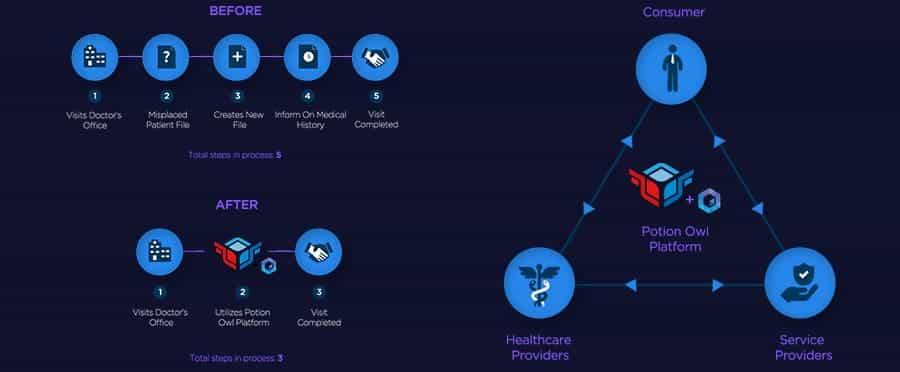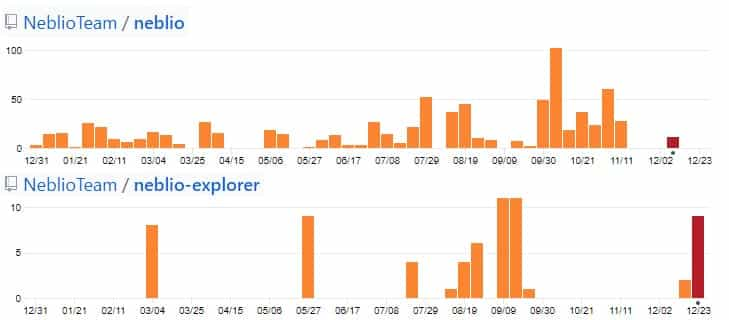Review of Neblio (NEBL): Platform for Enterprise Blockchain Solutions
Neblio (NEBL) is a project that is developing an open source enterprise blockchain solution.
This solution will be a secure and distributed platform upon which businesses can develop their own applications. Neblio is joining a long list of other projects that are working on similar enterprise blockchain development networks.
With so many alternatives, can they really compete?
In this Neblio review we will take an in-depth look at the project including it's technology, use cases and ongoing development. We will also analyse the potential for larger adoption of NEBL tokens in the long run.
What is Neblio?
Neblio is a project acting as a Blockchain as a Service (BaaS) platform, with a focus on enterprise customers. One of the main features of the Neblio blockchain is ease of use for everyone.

That includes developers as well as customers and users. Neblio is achieving this simplicity through the use of RESTful APIs which act as bridges to link applications that interact on the Neblio blockchain. Currently there are APIs available to developers in eight different programming languages:
- Java
- PHP
- Javascript
- Ruby
- Go
- Python
- C#
- Objective-C
The platform was developed so that any of these programming languages can be used to create apps, and these can publish data and query the Neblio blockchain via the APIs. This makes Neblio easy to use since developers can use whatever language they are most familiar with, rather than needing to learn a new language like Solidity in Ethereum.
This greatly broadens the pool of developers who can code apps for the Neblio blockchain.
Neblio Technology
Neblio is a Proof-of-Stake (PoS) blockchain, where holders are rewarded for staking their coins. The PoS mechanism was based off Peercoin, with certain modifications made to prevent manipulation and gaming of the network. The first change is there is no minimum amount of NEBL required for staking.
A second change was made to the maturity of staking coins, which must be held for 24-hours to stake. The developers also changed the stake payout to 10% annually. Neblio uses the Scrypt hashing algorithm that Litecoin (LTC) uses to secure its network.

Neblio was unique in that it was developed in “stealth mode” according to the founders. Basically this means that Neblio was developed in secret and was launched with no fanfare.
Neblio Team Members
The Neblio team is comprised of members who have experience in software development, blockchain and business. The co-founder and lead developer is Edward Smith. He has over 7 years in software development for companies including Capital one and Cisco. He holds a CS degree from the Georgia Institute of Technology.
The second co-founder is Ann Jackson. She has an MBA from Old Dominion university and a Bachelor of Science in business administration from the University of Virginia. Prior to founding Neblio she worked at Hewlett Packard for 6 years in a number of operations and marketing roles.

Joining them is Yuval Amar who is the marketing advisor. He has over 12 years of online marketing in fields such as real estate, fitness and Business intelligence. Neblio also has two developers, namely: Riley Stockton and Samer Afach.
Riley is a data scientist and has a BS in mathematics who has three years of experience in both front end and back-end development. He was also the creator of nebliostats. Samer has a doctorate in atomic and particle physics and has experience in network security and server management.
For a project with the scope of Neblio, it seems as if the size of the core team is a bit light. Although they have doubled their size since the ICO, they are going to need more talent to tackle their goals. This may change as we head into 2019 as it looks like Neblio is actively looking for development and operations talent to join the team.
In terms of communication with the community, Neblio has an official blog where they have laid out some of their development updates. However, they are much more active on their twitter account when it comes to announcements etc.
Unique Tokens on the Blockchain
Like Ethereum’s ERC-20 and ERC-721 standards, it is possible to create tokens on the Neblio blockchain. The team released this ability in stealth mode too, in December 2017. The tokens are based on the Neblio Token Protocol-1 (NTP1). These NTP1 tokens can be used for metadata storage and have all the same functions as fungible tokens, including smart contract functionality.
The fees for transferring NTP1 tokens are given to the NEBL stakers, giving them a greater incentive for staking. Because there is no minimum NEBL required for staking rewards to be earned every holder has an incentive to stake their NEBL tokens.
Fees are expected to scale alongside network usage, which could lead to large NEBL payments in the future. In fact, the increased staking rewards from fees was one reason the first NTP1 token called Trifid was developed.
Trifid (TRIF)
Trifid was developed as a payment token on the Neblio blockchain. The reasoning is that because of the strong staking rewards with the NEBL token users wouldn’t be likely to spend it, so a different token was needed as a transactional currency. With TRIF tokens in existence users have a transactional currency that allows them to hold and stake their NEBL.
TRIF tokens were airdropped to NEBL holders at a ratio of 100:1. The team hopes this will increase TRIF usage.
Cred (LBA) and Acre
Neblio’s partnership in financial markets began with Cred and recently evolved to include Acre. Cred now offers easy access to credit through their LBA token, while Acre lets anyone get started in crypto investing for as little as $10. With both financial markets seeing explosive growth, these platforms give great long-term growth potential for Neblio.
Potion Owl (PTN)
Founded in 2014, Potion Owl is a healthcare company based in Kingston, Jamaica. It has made the shift to the Neblio blockchain for its consumer facing functions that connect patients, healthcare providers and insurance companies.
The Potion Owl token (PTN) is a patient-centric token that is working to make patient interactions with providers simpler and easier. In Kingston all 354 healthcare providers who are clients of Potion Owl have agreed to implement the PTN token.

These tokens will be bought on the open market, but Potion Owl is working as the intermediary with their customers to make purchases easier. The PTN token price will be based on the market price, and the token will be used to power smart contracts. The initial use case is for the purchase and preparation of prescriptions, with data encoded over the Neblio blockchain.
Privacy protection is guaranteed through the use of blockchain technology, and the instances of prescription forgery and insurance fraud have been dramatically decreased.
Potion Owl is planning on spreading its program across all 28 Caribbean islands within a 6-month period. This is expected to help develop a strong community and inexpensive healthcare system across the region.
Development & Roadmap
In order to get an idea of how much actual work is being done a project, one of the best ways is to take a look at their GitHub activity. By observing the number of repository commits can get a rough idea of much code is actually being produced.
If we head on over to the Neblio GitHub repository we can see that they still seem to be relatively active. The team seems to have been quite active in the months of October and September of this year.

If we were to compare this to other projects you, Neblio comes in at 72 in terms of the total commits over the past 12 months. This places them just between Ether Zero and Bitcoin Cash.
Moving onto the road-map for 2019, it seems to be relatively sparse. They have stated on their website that 2019 is the year for "Iterative Innovation & Industry-Wide Adoption". They are merely stating that they will scale the delivery of their enterprise technology.
The NEBL Token
After launching the mainnet on July 21, 2017, the pre-sale for NEBL tokens began on August 6, 2017. Neblio took a unique approach to their ICO as well, offering all 125 million NEBL tokens for sale, and requiring even the founders and core developers to purchase tokens during the ICO. There were only 12 million tokens sold during the ICO at a price of $0.2032 each, and most of the remaining tokens were burned. Currently the total supply of NEBL is just over 14.6 million.

The NEBL token hit its all-time high of $58.99 on January 9, 2018, but like the rest of the cryptocurrency markets it has fallen drastically since then and remains depressed as of late December 2018. Heading into 2019 it is trading at $1.22, which is still 6x its ICO price, so early investors have been very well rewarded.
Most of the trading volume for Neblio is on Binance, although it is also available on KuCoin, Cryptopia and HitBTC.
For storing your Neblio tokens you can use the Orion web wallet, or one of the desktop wallets available for Windows, OSX, and Linux.
Conclusion
Despite the relatively small size of the team, they were able to meet their development milestones over the course of 2018. If they are able to adequetly fill the positions that they have got open, they could be well positioned to go into 2019.
One concern is in the marketing strategy of the project. The Neblio blockchain was developed and launched with little fanfare, and has not been very active promoting itself since. On the other hand, the NTP1 projects are very adept at promotion, and that could be enough to save Neblio from its own lack of promotion.
Another strength of the project is the staking rewards. With a 10% annual return on staking, Neblio is one of the strongest coins in that regard. It’s possible that some large investors could step in to take advantage of the large staking reward. It’s also possible a large enterprise could buy large amounts of NEBL if they have plans on creating an NTP1 token.
With development continuing at a rapid pace, and a product that is already proven to work, Neblio could be ready for a break-out year in 2019. Obviously the overall bearishness in crypto has held the price back, but if that changes it is possible there could be a renewed interest in NEBL.
Disclaimer: These are the writer's opinions and should not be considered investment advice. Readers should do their own research.
Disclaimer: These are the writer’s opinions and should not be considered investment advice. Readers should do their own research.
